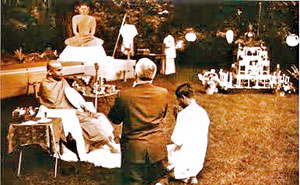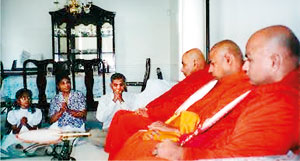Washington Buddhist Vihare: Service to humanity
View(s):
Ven. Madihe Mahanayaka Thera at Vesak celebrations in 1964
With the advent of the month of Vesak (May) this year, the first Theravada Buddhist temple in America celebrated its golden jubilee. The credit of establishing the temple goes to the late Agga Maha Pandita Madihe Pannasiha Maha Nayaka Thera. It was following his visit to Europe and America in 1964 that the idea was mooted.
It was May 25, 1964 – Vesak full moon Poya day. The Maha Nayaka Thera who was in Washington reminisces about the day in his diary: “I was amazed at the decorations at a public park to mark Vesak. Staff in the embassies representing Buddhist countries had taken great pains in arranging the place with flags, other decorations and lights. With drummers beating drums I was taken in procession under an ‘uduviayana’ and with ‘pavada’ laid just as is done in Sri Lanka. The Americans present were quite surprised when they saw the staffers from Buddhist countries holding high posts, prostrate and worship the preacher monk. After the sermon I chanted ‘pirith’. Olcott Gunasekera (he accompanied the Maha Nayaka Thera) translated the sermon into English. The Buddhists were so taken up that it was decided to build a Theravada temple.”
On the Maha Nayaka Thera’s recommendation the Sasana Sevaka Society decided to proceed with the setting up of the Washington Buddhist Vihara. The Maha Nayaka Thera felt that the Vihara should be run by a society registered in the USA. He would serve as the patron and the only obligation of the society was to obtain his consent in appointing the chief resident monk.
Society formed
The Buddhist Society was formed with Venerable Bope Vinita of the Vajiraramaya as the head of the temple and president of the Society. It is the day (May 1, 1966) on which the Society was incorporated that was celebrated as its founding.
Ven. Vinita was joined by Ven.Dickwelle Piyananda and both lived in a small apartment prior to locating a more spacious place for the Vihara. Negotiations were begun to buy a building used by the Thai embassy which was for sale. It took several months to finalise the deal but when it was virtually finalised the Thai embassy permitted the place to be occupied. Sometime in 1968 Ven. Henepola Gunaratana Thera was also appointed and Ven. Vinita Thera who was studying at Harvard University, returned to Sri Lanka. Ven.Gunaratna (popularly referred to as Bhante G) recalls the early days in his autobiography: “My very first evening at the vihara, Venerable Piyananda said to me, “I’m the old grandfather here. But you are young and vigorous and you have a lot of experience. This place needs work and I want you to take on that job. I’ll be figurehead, here to advise you whenever you need help. But I want you to be in charge’.”
Temple takes shape
The huge house with eight rooms and four bathrooms needed total renovation. “I didn’t know what I was doing. I had no construction experience whatsoever, so I walked one mile to the nearest hardware store and started asking questions. For big projects, I had to wait until enough donations came to pay for our materials. Then I had to carry home any materials I purchased, including lumber,” Bhante G remembers. “After a while I had some help from a few Thai people who came to the temple. And eventually, some Burmese and Vietnamese families also joined. Downstairs we tore out walls and turned several rooms into one large one, to serve as a shrine room for devotional services. Then we went to work making the bedrooms livable.”
“I was also responsible for the other daily tasks at the temple – grocery shopping, cleaning, mowing the lawn, running the office, collecting donations and teaching Dhamma classes. To attract more members, I decided to print a monthly newsletter. I produced it on a hand-cranked mimeograph machine. Most of the time, I was exhausted,” he writes. “As a monk living in Asia, I have been waited on much of my life. Never did I expect to come to America and be a manual labourer and a cook and a repairman.”
After much effort in December 1968, on Bhante G’s 41st birthday, the sale of the building was finally closed for $33,000.
Regular programmes were started. A meditation class was held three evenings a week. Sunday afternoon was the devotional service. Vesak was celebrated in Sri Lankan style. The newsletter was continued.
After twenty years, Bhante G moved out and set up a forest monastery.

The Mahanayaka Thera on a later visit to Washington with Ven. Dhammasiri Thera (present chief prelate and Sanghanayaka of North America) and Ven. Tiricunamale Ananda Thera (now Mahanayaka Thera of the Dhammarakshita Nikaya)
Twenty years later
Madihe Pannasiha Maha Nayaka Thera’s senior pupil, Ven. Maharagama Dhammasiri Thera took over from Bhante G in 1988 and remains the resident head monk up to now.
The genial personality has proved his capabilities in managing a fast-growing institution with more and more showing an interest in Buddhism. They are most keen on meditation and Bhante Dhammasiri has succeeded in creating an interest even among the young boys and girls to meditate.
Several years ago on a visit to Sri Lanka he told me how tension and stress have led more and more Americans to turn to meditation for relaxation. “With only a few holidays, their life revolves round work. Their stress levels are high. So they try to get away for an hour or two on Sundays to follow our meditation classes,” he said. He sees the accent of those interested in Buddhism turning from Buddhist philosophy to meditation. With the growing interest in comparative religions in the university curriculum, in recent years more and more students have been turning to Buddhism. Groups of students have been coming to the Vihara looking for material. He has been having a busy schedule speaking at seminars and delivering lectures. “There is always a lot of interest when a Buddhist monk attends gatherings. So many questions are asked about the robe, its colour, why the head is shaven and so on,” he told me.
Incidentally, Bhante G relates the story how he, being small-made, wrapped in robes and with a shaven head, when he asked directions to a public restroom, the person would point to the women’s room. “One day, I was walking home from the grocery store, my arms full of bags, and I passed a man washing his car in a driveway. His dog rushed at me. The man scolded him: ‘Don’t bother the nice lady!” He remembers how during the 20 years he lived in Washington, every day the cheerful mailman would greet him “Here’s your mail, ma’am”.
Having been ordained when he was ten years old, now over 50 years in robes, Bhante Dhammasiri is “a seasoned campaigner”. In appreciation of his services to the Sasana, he was appointed the Sangha Nayaka of North America by the Dhammarakshita sect of the Amarapura Nikaya.
The photographs and the video clips appearing on the Vihara website and Facebook relating to the May 1 ceremony amply demonstrate how much Bhante Dhammasiri has achieved. Leaving aside the lay devotees, the number of the Maha Sangha present not only from the temples in America but from abroad as well, showed how active, energetic and dynamic he has been apart from winning everyone’s hearts.
The announcement by the Mayor of Washington DC declaring May 1 as the ‘Washington Buddhist Vihara Day’ is itself a symbol of recognition of what the Vihara hasmeant to the people over the past 50 years. A most commendable effort indeed!
- D.C. Ranatunga


